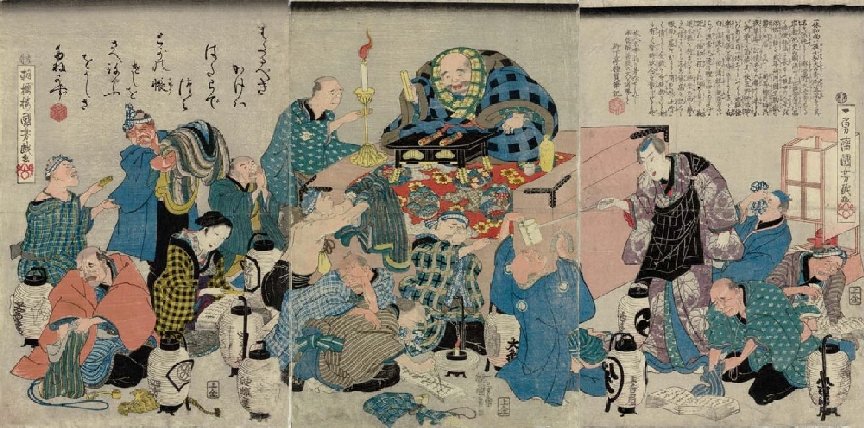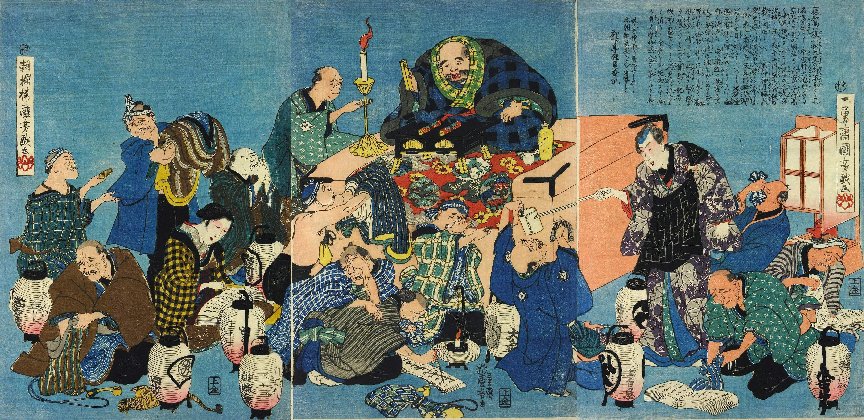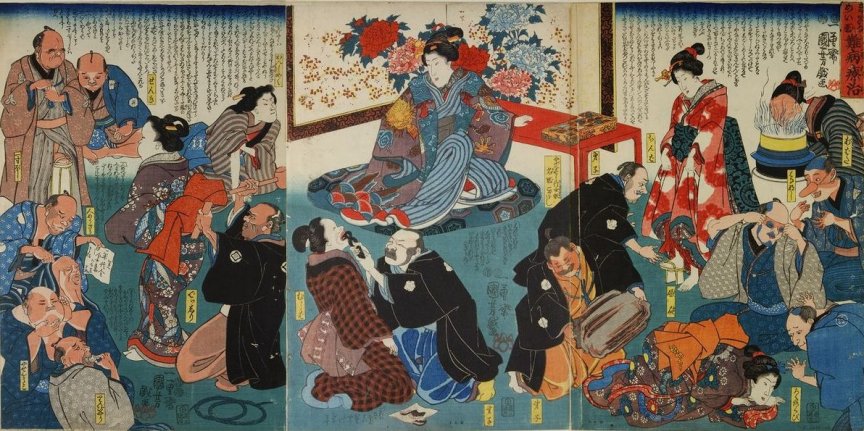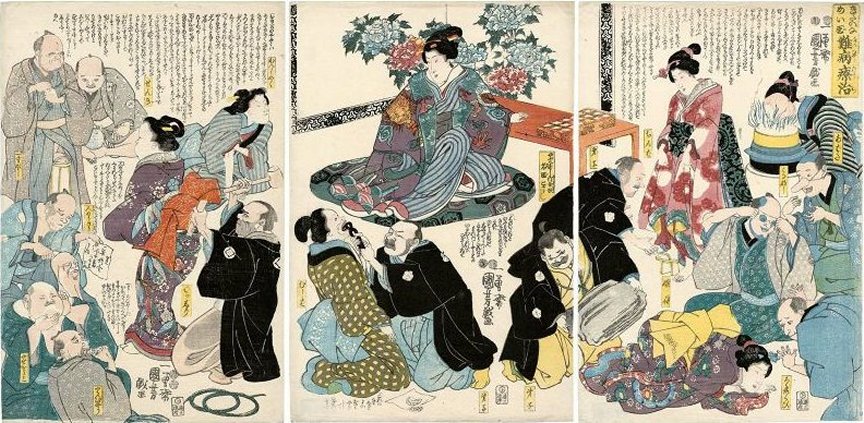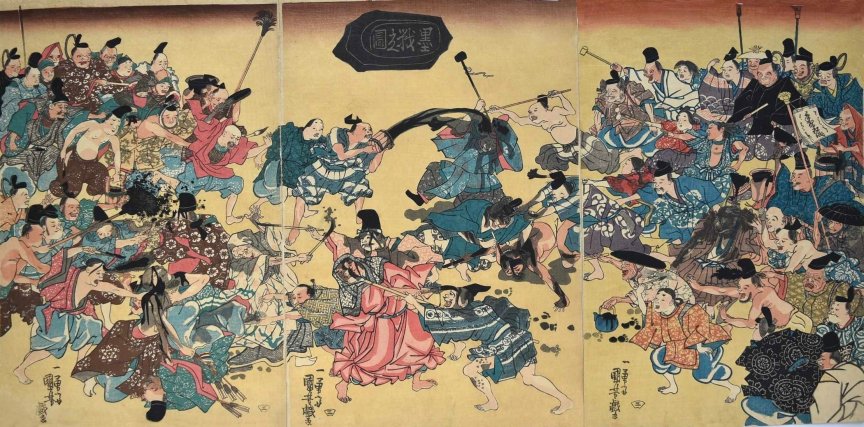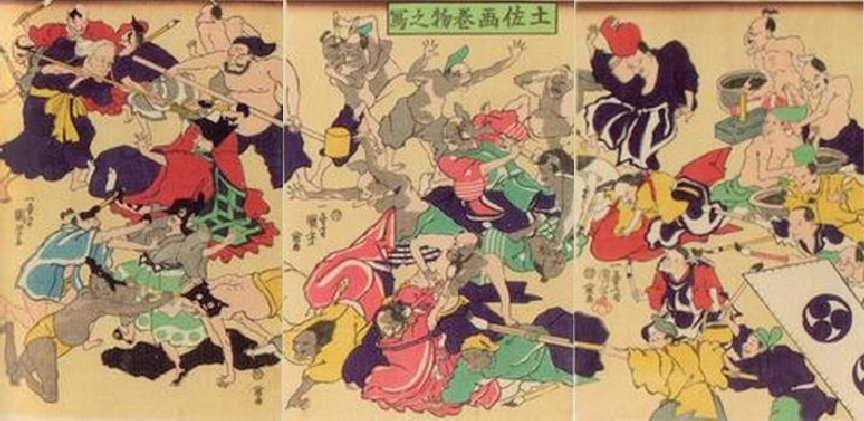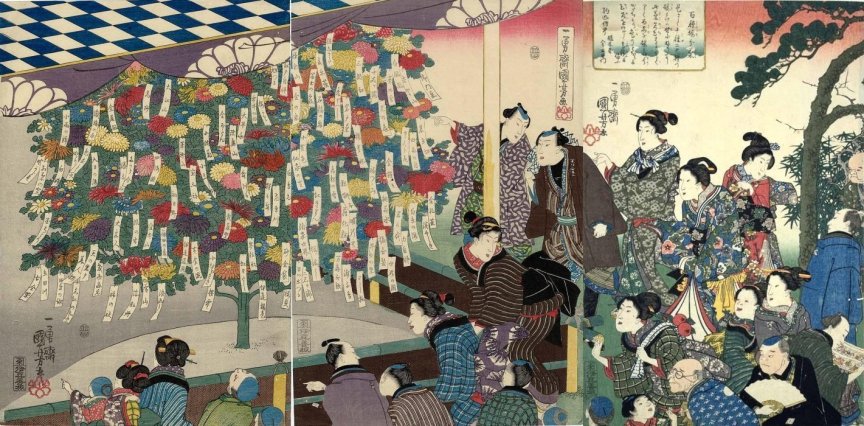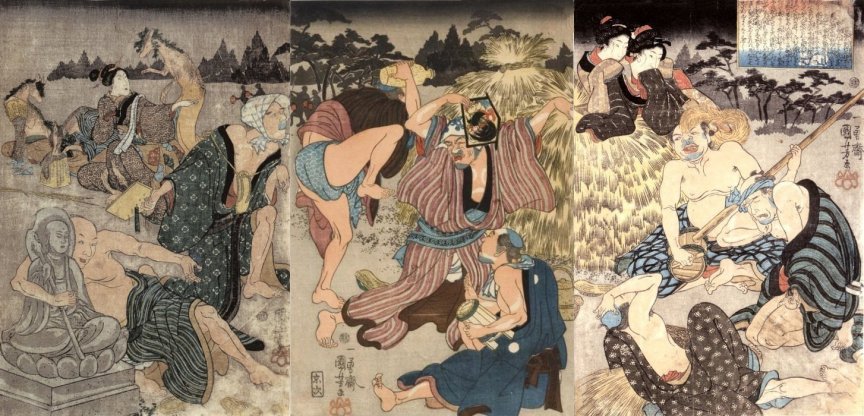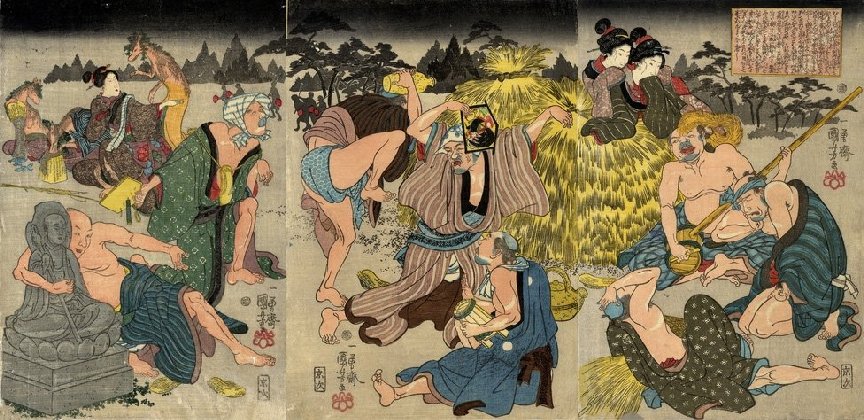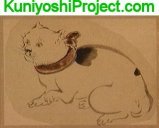Comic and Miscellaneous
Triptychs and Diptychs,
Part IV
|
Title: The Foxesĺ
Wedding (Kitsune no yomeiri
no zu) Description: The red torii of the Inari Shrine on the far right is the starting point
of a foxesĺ wedding procession passing through a cedarsĺ alley. The foxes
depicted in the centre have fully transformed into human beings while the
heads of the figures in the left and right panels still resemble foxes. The
animals in front of and behind the procession are entirely foxes.á The term kitsune no yomeiri (foxĺs wedding)
refers to the occurrence of rain occurring during brilliant sunshine, which
is said to occur a fox bride is going through the woods to the house of her
fox groom Date: 1839-1842 Publisher: Eshima |
|
Title: The False Ikkyű Preaching to the Bill Collectors (Nise no Ikkyű osh˘ sepp˘
no zu, 偽一休和尚説法之圖) Description: Nozarashi Gosuke disguised as
the priest Ikkyű giving sermon at foot of Ikoma-dake in Kawaguchi Province.á The sermon is about the terrible agonies
suffered by the rich in hell, especially when they fail to forgive
debts.á The listeners are crying, and
one is crossing out entries on his debt register (center sheet). Date: 1843-1846
(censor Murata Sahei) Publisher: J˘shű-ya Kinz˘ |
|
An alternate state of the above triptych |
|
I am grateful to Robert Pryor for this
additional state of the above design. |
|
Title: A Great Doctor
Treats Serious Diseases (Kitai na meii nanby˘ ry˘ji,
きたいなめい医 難病療治) Description: The female
doctor Kogarashi, daughter of the quack doctor Chikusai (Yabukusushi Chikusai musume meii Kogarashi), sits in
the center in front of a floral screen; her four disciples, in black jackets,
apply humorous ôtreatmentsö to patients.á
Thought to be a political satire. Date: 1849-1852 (censors
Hama and Magome) Publisher: Enshű-ya Hikobei I am grateful to Ward Pieters for information about this print. |
|
A less labor intensive edition of the above design |
|
Title: The Ink
Battle (Bokusen no zu, 墨戦之圖) Description: During the
Nara period pouring ink was a favorite pastime at the Imperial court as a
narrative scroll from the Tosa school illustrates. Therefore, Kuniyoshiĺs
print superficially appears to be a copy of the Tosa scroll. However, the
person next to the general wearing a kimono
with the wave pattern could be the senior councilor Mizuno Tadakuni, while the woman in front of him would be the
Shogunĺs mistress. A majority of the depicted figures wear a headgear common
among courtiers. The hidden message behind this print is that the samurai
have become as weak as the court officials, wasting their time with ink
battles, which has allowed even women and monks to seize power. Date: 8th
month of 1843 Publisher: San (phonetic
pronunciation of 三) |
|
Title: Copy of a
Scroll Painting of the Tosa School (Tosa e makimono no utsushi, 土佐画巻物之写) Description: Many figures scurrying
about, some fencing with pens, and others mixing ink to go into an inkwell Date: 10th
month of 1860 Publisher: Echigo-ya Kajű |
|
I am grateful to Robert Pryor for this alternate
state of the above design. |
|
Title: A Picture of
the Carpenters of Hida Erecting Pillars (Hida
no takumi hashiradate no zu) Description: The
construction of a kabuki theater
with actors in the lower half Date: 1842 Publisher: Iga-ya Kanemon |
|
Kuniyoshi and the publisher were fined in the 5th
month of 1842 for depicting actors, so the triptych was reissued with the
names removed.á |
|
Title: Flowers of
Gold in Full Bloom (Zensei kogane no hana, 全盛黄金花) Description: A man takes
gold coins from a wooden tray table (sanb˘) throwing the money at the fighting crowd.á The scene shown in this print relates to
the dream of every customer of the pleasure quarters. Once in a lifetime one
wants to own the most expensive, exclusive courtesan (oiran) of all Yoshiwara
establishments. If one could afford this huge amount of money, the event was
celebrated in public, and the lucky customer would shower the crowd with gold
coins, which actually were oval.á Date: 12th
month of 1858 Publisher: Yamaguchi-ya T˘bei |
|
Title: Suikoden,
Urashima Tar˘ (水滸伝, 浦島太郎) Poem: Suikoden From the abode of devils 108 creatures come forward Urashima Tar˘ opens the treasure box Description: Good spirits
(zendama)
and evil spirits (akudama)
are emerging from Urashimaĺs treasure box (tamatebako, 玉手箱) Date: 1842-1846
(censor Fukatsu Ihei) Publisher: Kita-ya Magobei |
|
Title: Exhibition of
a Chrysanthemum with 100 Different Flowers (Hyakushu tsugi wake giku, 百種接分菊) Description: A large group of people is
admiring the colorful blossoms of a huge chrysanthemum tree grafted with many
different varieties Date: 9th
month of 1845 (censor Fukatsu Ihei) Publisher: Izuzen |
|
Title: Getting Rid
of Sleepiness (Nemuke zamashi) Description: In the centre
of the scene is a group of fighting blind men.á Two barking dogs, a rice seller and two
women are watching the fight. The image title Nemuke zamashi (Getting rid of sleepiness) is an illusion to
a battle of the blind. With their eyes closed, the blind seem to be sleeping.
In this fighting scene the blind are randomly hitting and beating in various
directions.á Kuniyoshi seems to be
caricaturizing the disconcertment of Edo society. Date: 1846-1848
(censors Muramatsu and Yoshimura) Publisher: Sagin |
|
Title: Hyakush˘ kitsune ni bakasareru zu Description: A group of eight
men are dancing and singing in a rice field at harvest time. The inscription tells the story
of a sick man who was driven mad by a fox (kitsune). The eight farm workers taking the form of kitsune are depicted on a rice field
close to a village.á The barely clothed
workers are singing and dancing while shape-shifting into foxes.á One of the men is embracing a statue of Jiz˘ Bosatsu, the guardian of
souls in hell. The two beauties (bijin)
depicted on top of a bale of straw are about to transform into foxes. The
foxes in the background are taking the shape of women.á A group of people far away is looking with
lanterns for the men who have not returned home from their work in the
fields. Date: 1846 (censor
Murata) Publisher: Ky˘ji (京次) |
|
I am grateful to Robrt Pryor for this alternate
state with a solid colored title cartouche. |
|
Title: A Picture of
the R˘nin Irie of Sakamoto in G˘shű
Bewitched by a White Fox (G˘shű Sakamoto Irie
no r˘shi byakko ni taburakasaruru no zu, á江州坂本入江の浪士á 白狐にたぶらかさるゝ圖) Description: The triptych
relates to a tale in the Ehon Taikoki, Shinsho Taikoki
and other sources where Akechi Samanosuke and Irie Chobei kill a supernatural old white fox.á One of the foxĺs minions takes revenge on
Irie Chobei and his son Irie Koshichiro.á Akechi is the figure in the left panel
observing from behind a tree. Date: 1849 (censors
Kinugasa and Yoshimura) Publisher: Izutsu-ya Sh˘kichi NOTE: G˘shű is an old name
for ďmi Province, now Shiga, which includes Lake
Biwa, and Sakamoto is a town on the southwest corner of the lake.á Kuniyoshiĺs image appears to have been
inspired by this plate from Ehon Taikoki, which was published in 1797 and
illustrations of Okada Gyokuzan (1737-1812):á
I am grateful to Robert Pryor for the information about this
triptych. |
|
Title: G˘d˘ shiniĺe Description: Date: 1855 Publisher: NOTE: This print is
unsigned |
áá
|
|


